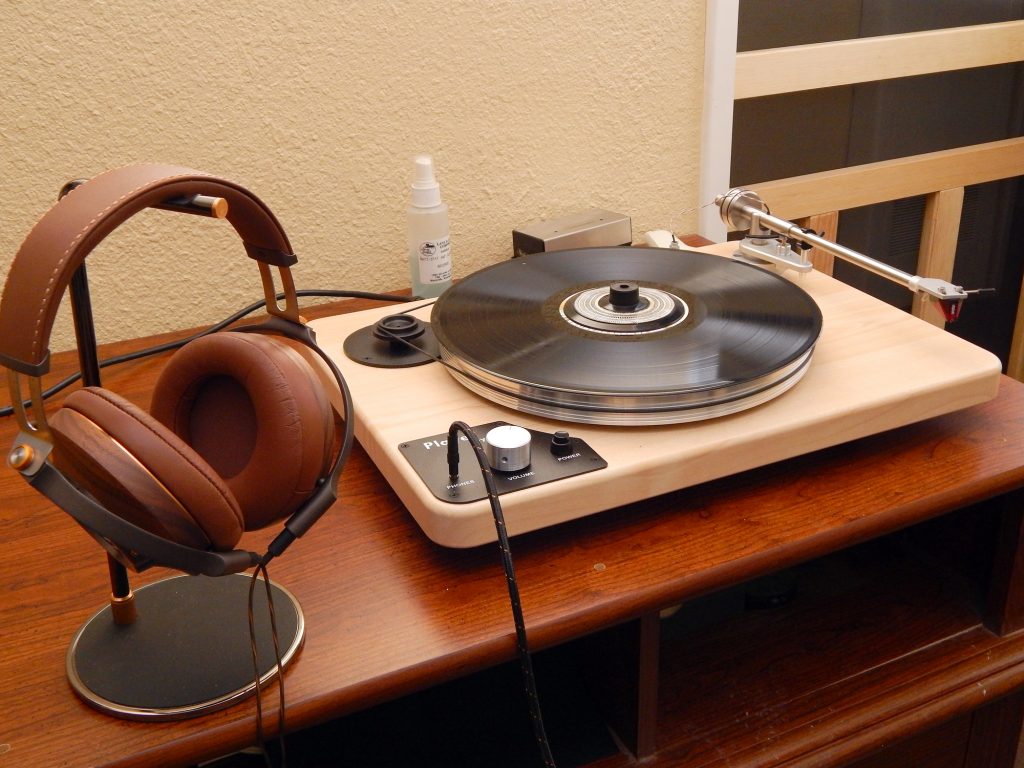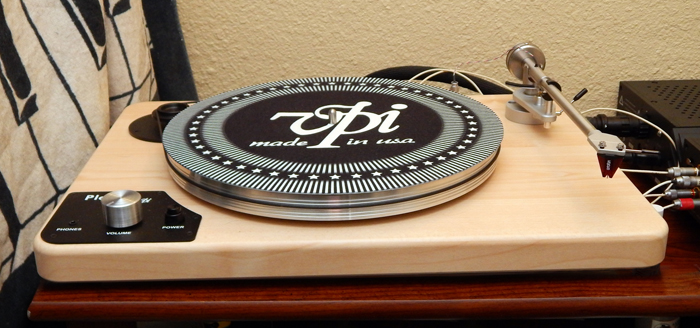It is not much of a secret that I am a vinyl-head. I have over 2000 records, 10% of which are audiophile pressings (as opposed to audiophile recordings of which I have about 50). Back in the late 80’s I ran a small by appointment only boutique high-end audio shop, and one of the products we sold was the then best turntable in the world, the VPI TNT Turntable. Little has changed since then in that despite being able to spend over $150 K on a turntable these days, VPI still makes one of the best and you would be hard pressed to find one that sounds better. What has changed is that at that time an entry level VPI Turntable would cost you about $3,000 without tonearm (my ’85 Honda CRX cost less than $5,000 new) and now you can buy a VPI Player with tonearm, cartridge and built in preamp/headphone amplifier for only $1,500.
I hear you saying, “What’s the big deal, my Close N’ Play only cost me $50?” Well the truth is a turntable’s job is extremely hard, probably harder than any other component in your system, especially if you want to achieve a level of sound quality that will compete favorably with a good DAC and make it worth putting up with the foibles of vinyl for something other than hipster nostalgic purposes.
To say analog recordings, in particular vinyl media (magnetic tape has its own set of issues which are compounded to vinyl as most records were made from tape masters), are intrinsically better than digital recordings is to say a half truth at best. For dynamic range and noise floor, digital wins hands down. For frequency response, vinyl beats CD and DAT (digital audio tape) and ties with 24/96 kHz but gives way to higher sample rates, but where analog is king, and this includes vinyl, is timing, and that is what creates soundstage and imaging.
So back to turntables. A turntable’s first job, and by no means the easiest, is isolation, both from the environment and itself. External noise in the form of vibrations and resonance (including noise created by the motor) can be picked up by the phono cartridge which is not dissimilar to a microphone (both convert vibrations to electricity), not only that, if that resonance is the sound produced by the speakers connected to the turntable, it can create a feedback loop which will steadily increase until disrupted (you most likely have experienced microphone feedback, same thing). On top of that, resonance can be picked up by the turntable platter, which causes micro changes in the platter speed called flutter (this is why belt drive is preferable to direct drive for audio purposes, because the belt creates a layer of isolation between the motor and the platter). Which brings us to the turntable’s second job; the motor and platter must work together to turn the record at a constant speed without wow (slow changes in speed) or flutter (fast changes in speed). Next we have the tonearm, which must keep the cartridge and stylus aligned with the record groove both vertically and horizontally in all three planes of movement, while being able to freely track across the record and adapt to abnormalities in the records (like warpage) and at the same time maintain the correct tracking weight, keeping the cartridge as steady as possible to facilitate as much energy as possible being transferred from the stylus to the cartridge. I could go on, but I think the point has been made.
The VPI Player:
The Player is an incredibly elegant and attractive table. The 1.25”” thick textured vinyl covered non-resonant MDF plinth is available in Hard Rock Maple and Mocha Walnut, I opted for maple. The aluminum platter rotates on an oil bath bearing and is fitted to a shaft with a #2 Jacob’s Taper for a concentric rigidly mounted coupling. The bearing has a PEEK thrust disc and machined graphite impregnated brass bushings using a Thompson Engineering 60 Rockwell case hardened shaft. The tonearm is a Gimballed 9” vertical Yoke type tonearm with a lateral turntable type bearing. And the build quality is astounding, especially for an entry level turntable. There is also a list of upgrades that can be added as your needs become more sophisticated, so while the Player may not be your last turntable purchase, it doesn’t have to be a short lived one.
The Sound:
I began my listening of the Player using the Klipsch HP-3 headphones which turned out to be a good match, the horn like qualities of the HP-3 was totally complemented by the warmth and musicality of vinyl. But to take a more critical look, I switched to my reference headphones the MrSpeakers ETHER C Flow Orthodynamic headphones. I should point out that the Player’s headphone amp is more geared towards higher impedance headphones, this is evidenced by the fact that it puts out more power at 150 ohms that at 32 ohms (all things being equal, the opposite should be true), but I had no trouble driving either the HP-3s or the ETHER C Flows.
Putting on The Alan Parson Project’s Tales of Mystery and Imagination Edgar Allan Poe I sat back and was enveloped in sound. The piano and strings of “The Cask of Amontillado” were rich and full while the vocals were ethereal and emotional. The soundstage had great width and depth, very three dimensional. The horns were deep and textural and the overall presentation was lively and dynamic.
The stereo separation is such that for a moment I thought a channel had gone out during the opening burr of the Fender Rhodes at the beginning of “Pretzel Logic” (Steely Dan – Pretzel Logic). The bass guitar was tight and pervasive at the same time while the percussion was fast with excellent decay. Again the soundstage branched out in all directions giving a real sense of space.

My Noble Katanas proved to be too low of impedance for the Player’s built in headphone amp, as the bottom end was sharply rolled off, but the sound was still epic while listening to No Heroes by Jamie Sheriff bringing back all the excitement of 80’s New Wave.
Figuring it was time to kick things up a notch, I connected the Player to the HeadAmp Blue Hawaii Special Edition to take a lap with the brand new MrSpeakers VOCE Electrostatic Headphones. Having saved listening to classical music for this moment, I broke out my copy of “The Firebird Suite” as performed by Robert Shaw and the Atlanta Symphony Orchestra (Stravinsky: The Firebird; Borodin: Music from Prince Igor). The Firebird is a very subtle piece despite its incredibly flashy dynamic crescendos, employing many solo instruments with similar sound, at one point the melody goes from fife to flute to oboe to clarinet to violin to French horn, interweaving the different instruments. With this playback combination, the tonal balance was pitch-perfect, making it easy to identify and locate each instrument. For the first time, I heard a fluttering of interwoven flutes. To say the experience was transcendent is not to over dramatize.
The Ball of Wax:
The VPI Player Turntable is an amazing value, and a fantastic entry level table that can grow along with you. The built in headphone amplifier is very convenient and provides good sound, though you will see a marked improvement using a higher end headphone amp. The same goes for the built in preamp, which can be bypassed (I believe this is a dealer doable mod) to use a higher end piece or for use with a moving coil cartridge. For me, the weakest link is the cartridge, but there are many excellent moving magnet or moving iron cartridges that can be upgraded to without necessarily breaking the bank.
To the question of does the Player rise to the level required to compete with digital, I think the answer is a resounding yes. While vinyl is a lot more demanding than digital, requiring both quite a ritual to listen to and much greater attention to the music, it can be a very rewarding experience for someone who wants to be totally immersed in the experience of music.

http://www.vpiindustries.com/player
Price: $1,500
PLAYER SPECIFICATIONS:
Type: Belt drive (manual turntable)
Motor: 24 VAC Synchronous AC Motor
Turntable Platter: Machined MDF
Diameter: 11.81″ (30.0 cm)
Turntable Speeds: 33-1/3 RPM and 45 RPM
Wow and Flutter: 0.06% WOW (In accordance with DIN specification) 0.04% Flutter (In accordance with DIN specification)
Rumble: less than-80dB (IEC 98A Unweighted)
Effective Arm Length: 240.7 mm
Overhang: 0.65″ (16.4 mm) Lofgren A
Offset Angle: 21.8°
Arm Mass: 10g (without cartridge)
Stylus Pressure Adjustment Range: 0 – 3g (with 4 g cartridge)
Cartridge: Ortofon 2M Red
Output: 5.5 mV @ 1 KHz
Phono Preamplifier: Gain 35 db
Cartridge Loading: 150 pF Across 47K Ohms
Frequency Response: 20 Hz – 20 Khz (-0.5 db at 20 Hz)
Low Frequency Rolloff: -1.4 db @ 10 Hz
Output Voltage: (on RCA Jacks) 287 mV @ 1 KHz
Headphone Amplifier Gain: 10 db
Frequency Response: 20 Hz – 20Khz (-0.4 db at 20 KHz)
Output Level: 395 mW per Channel @ 150 Ohm 165 mW per Channel @ 32 Ohm
Power Supply: 24 VAC @ 50 – 60Hz
Power Consumption: 7.7W at full output with 32 Ohm headphones
Dimensions: 18.5″ (470 mm) W x 13.5″ (343 mm) D x 4.3″ (109 mm) H
Weight: 12.9 lbs. (5.9 kg)


















Want to join discussion?
Feel free to contribute!